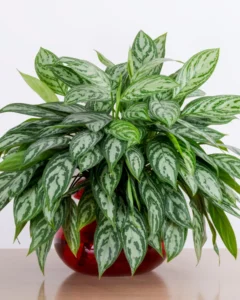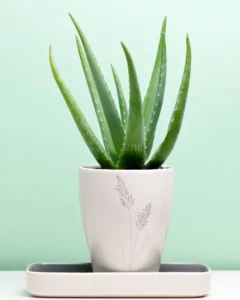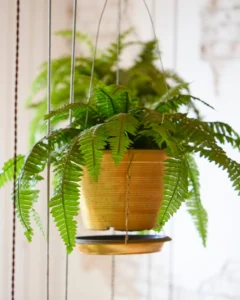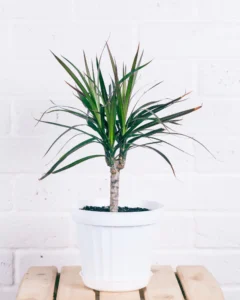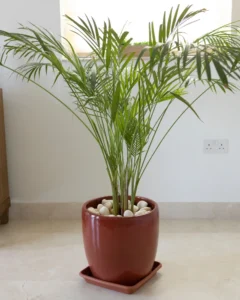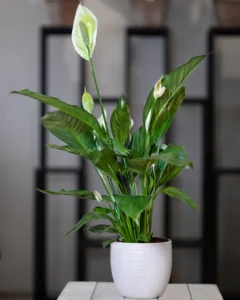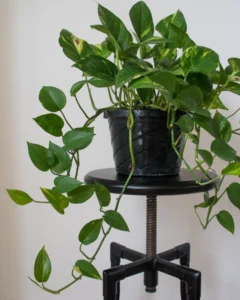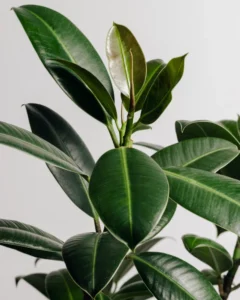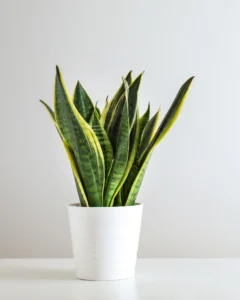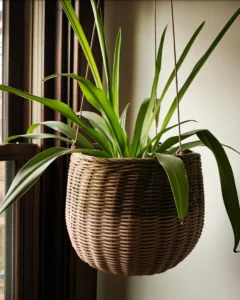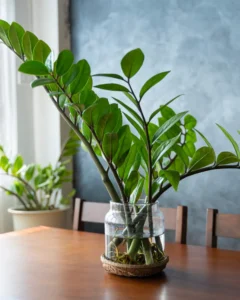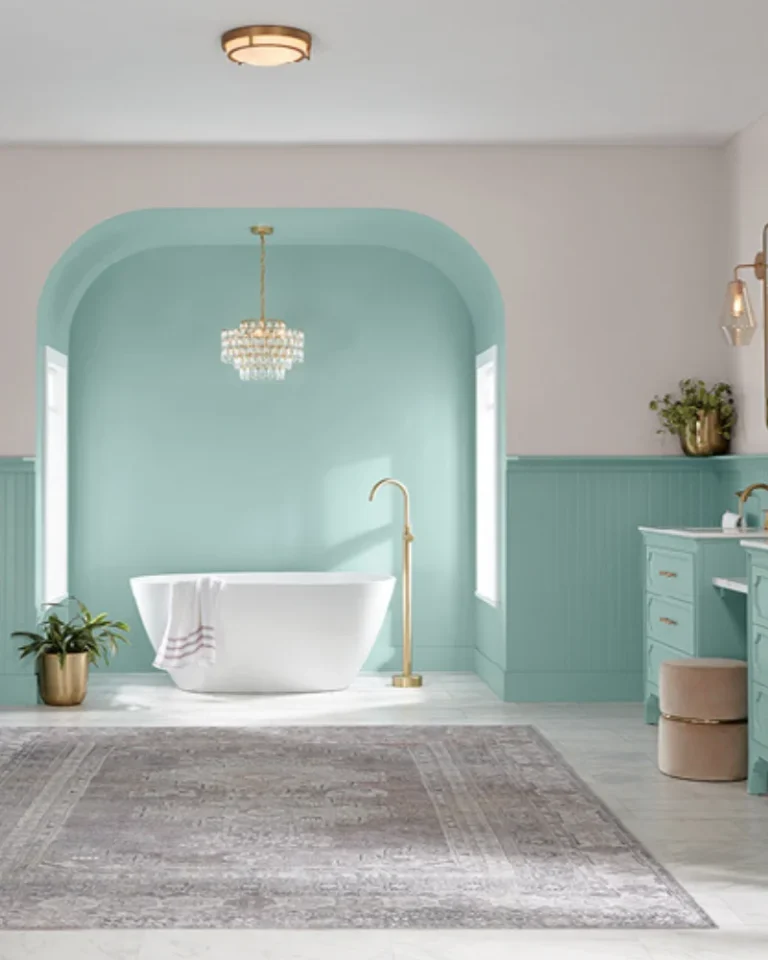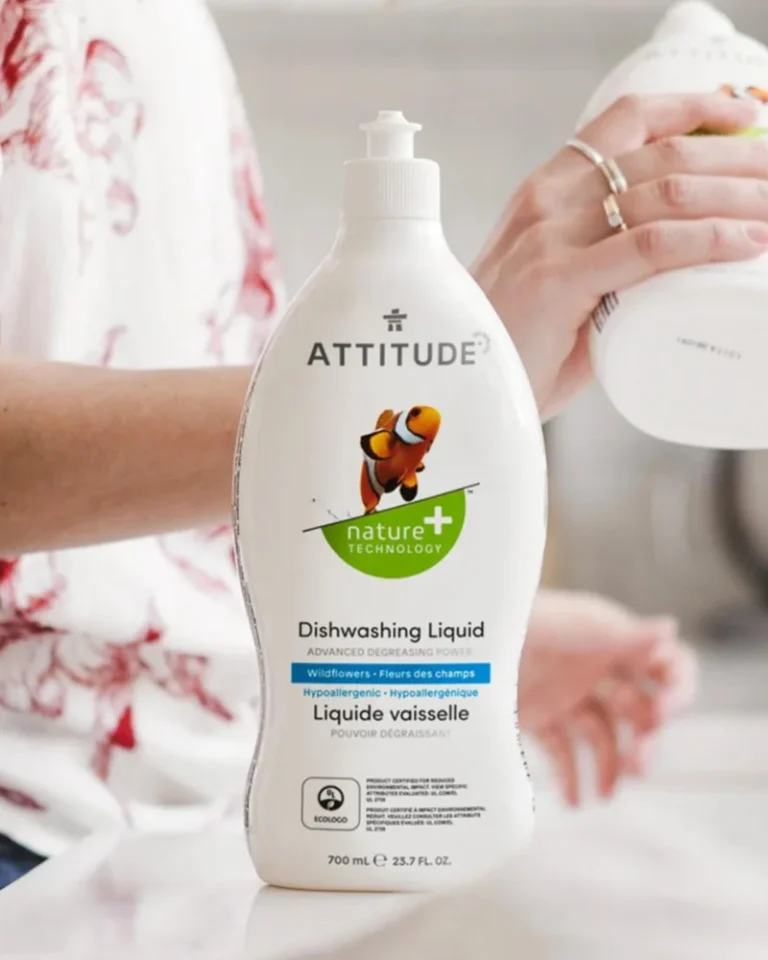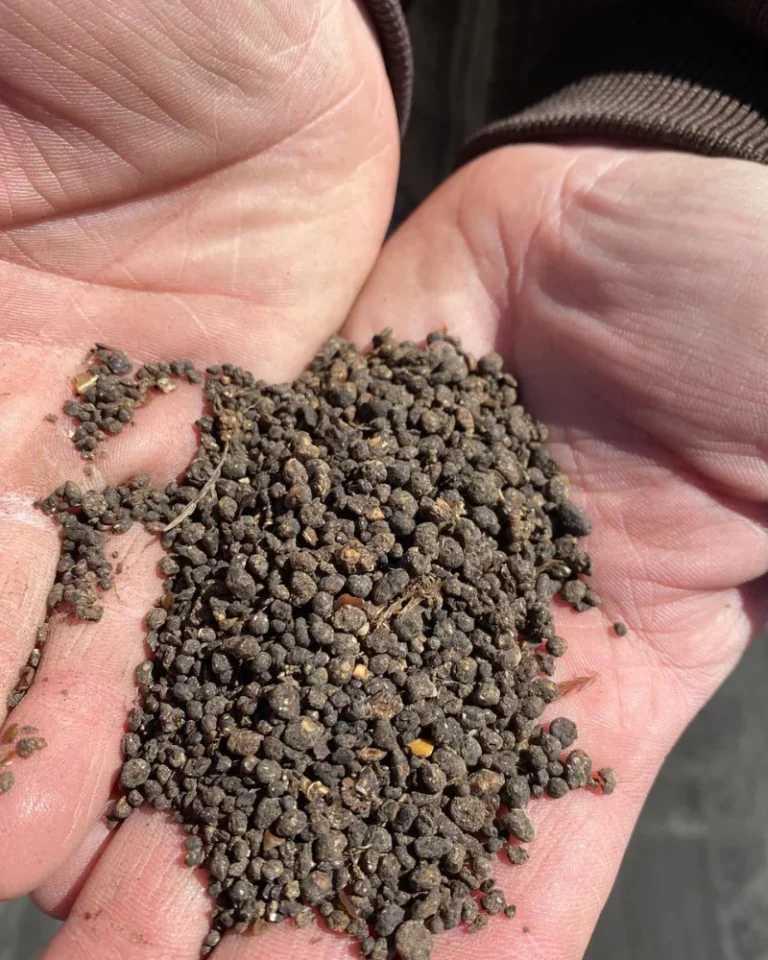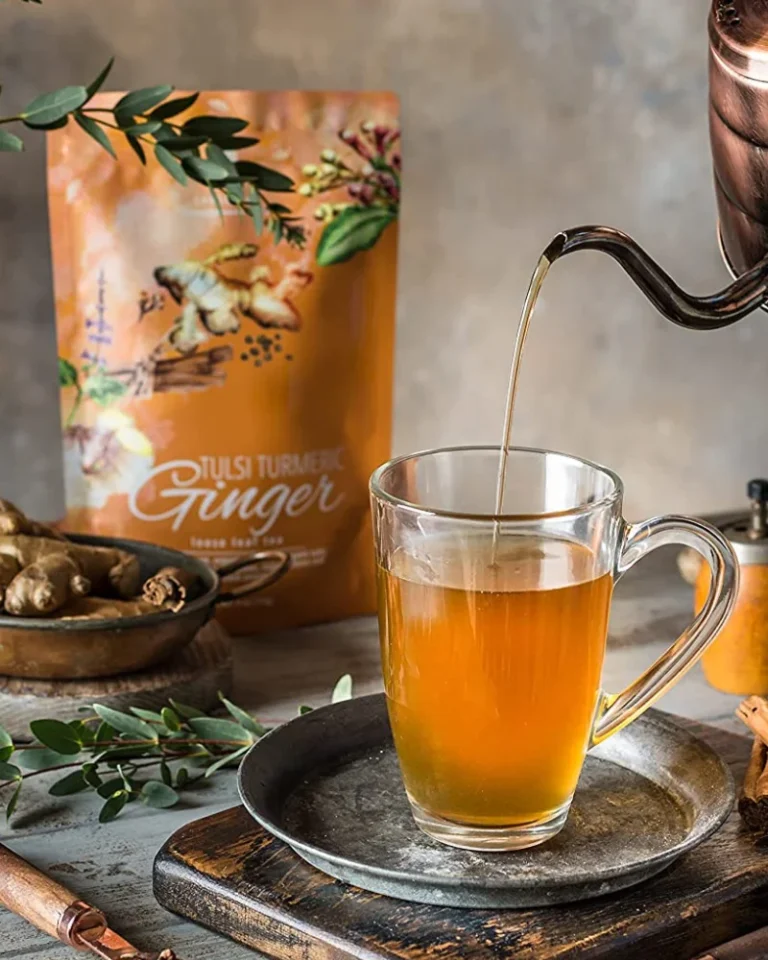This post may contain affiliate links. By browsing this website, you agree to our disclaimer, privacy policy, and terms of use.
Concerned about the air quality in your home? Looking for ways to naturally purify the air in your indoor spaces using eco-friendly house plants?
You’re in the right place! The THC experts have researched 11 of the best eco-friendly air-purifying houseplants that will keep your home’s air fresh and clean. Some are even NASA-approved!
Indoor air pollution is a growing concern, with studies showing that the air inside our homes can be up to five times more polluted than the air outside.
From volatile organic compounds (VOCs) emitted by furniture and cleaning products to allergens like dust mites and pet dander, the air we breathe every day can be filled with harmful toxins that can take a toll on our health.
But not to worry! Eco-friendly air-purifying houseplants are nature’s own powerful air filters.
Not only do they add a touch of green to your decor, but certain plants have been scientifically proven to purify the air, removing toxins and pollutants that can cause everything from headaches and fatigue to more serious health problems like heart disease and cancer.
In this article, we’ll introduce you to the 11 best air purifying houseplants that can help you breathe easier and live healthier.
11 Eco-Friendly Air-Purifying Houseplants
1. Aglaonema
The Aglaonema, also known as the Chinese Evergreen, is one of the most popular eco-friendly air-purifying houseplants that not only looks beautiful but also boasts impressive air-purifying properties.
Listed in NASA’s Clean Air Study, the Aglaonema can effectively remove common VOCs from indoor environments, including toxins like benzene and formaldehyde found in many household products like gasoline, paints, and building materials.
In addition to its air-purifying superpowers, the Aglaonema offers other health benefits, like stress reduction and increased feelings of well-being, thanks to its vibrant foliage.
Caring for an Aglaonema is easy. It thrives in bright, indirect light and prefers moderate humidity.
Benefits:
Filters indoor air | Removes: Benzene, Formaldehyde | Improves sleep quality | Easy to care for | Reduces stress
When you think of the Aloe Vera plant, you probably think about soothing a sunburn, right? But did you know it can also help clean the air in your home?
The humble Aloe is capable of removing formaldehyde and benzene, which are commonly found in household cleaning products and paints.
In addition to removing harmful pollutants from the air, the gel inside the leaves can be used as a remedy for sunburns, minor cuts, and scrapes due to its anti-inflammatory and moisturizing properties. If you’re feeling brave, you can even consume the gel to support gut health.
Aloe Vera is a low-maintenance succulent that thrives in bright, indirect sunlight. It requires well-draining soil and should be watered deeply but infrequently, allowing the soil to dry out completely between waterings.
As a resilient and easy-to-care-for succulent, Aloe Vera is a great choice for beginners looking to add some greenery to their space.
Benefits:
Moderately filters indoor air | Removes toxic pollutants: Benzene and formaldehyde | Soothes skin with its anti-inflammatory properties | Easy to care for
The Boston Fern is not just another pretty plant. It’s a natural humidifier that can help restore moisture in the air, making it perfect for those who suffer from dry skin and dry noses.
But that’s not all! This lush green beauty is also great at removing formaldehyde, xylene, and toluene from its environment.
Formaldehyde is commonly found in building materials, adhesives, and furniture, while xylene and toluene are present in paints, varnishes, nail polish removers, and glues. Exposure to these toxins can cause irritation to the eyes, nose, and throat, as well as headaches and dizziness.
The Boston Fern requires more maintenance than many of the plants on this list. So, if you are new to caring for houseplants, this may not be the right choice for you.
Boston Ferns love high humidity and indirect light and prefer a cool place with consistently moist (but not soggy) soil. They are great air purifying plants for bathrooms, where they can soak up the natural humidity.
With the right care and attention, this air-purifying powerhouse will thrive and contribute to a healthier home.
Benefits:
Filters indoor air | Removes toxic pollutants: Formaldehyde, Xylene, Toluene | Increases humidity, which is potentially helpful for allergies | Requires moderate care
Looking for an eco-friendly air-purifying houseplant that’s easy to care for? Look no further than the Dracaena!
This popular plant comes in many varieties and is a great choice for improving your indoor air quality.
Dracaena varieties like Corn Plants and Marginata are listed among NASA’s Clean Air Study plants, which means they can effectively remove common VOCs from indoor air. These include benzene, formaldehyde, and trichloroethylene.
Dracaenas are adaptable to various light conditions. However, they thrive in bright, indirect light but can also tolerate lower light levels. Just avoid direct sunlight, which can scorch the leaves.
Overall, Dracaena plants are a versatile choice for anyone seeking to improve indoor air quality while enjoying a low-maintenance, attractive houseplant that contributes to a cleaner and more relaxed home.
Benefits:
Filters indoor air | Removes toxic pollutants: Benzene, Formaldehyde, Trichloroethylene, Xylene | Reduces stress and boosts mental health | Moderately easy to care for
In addition to adding a lush, tropical feel to any room, the Bamboo Palm is known for its ability to remove household VOCs from the air. These include formaldehyde, benzene, and even carbon monoxide (an odorless gas from fuel-burning appliances that can be deadly at high concentrations).
Not only does the Bamboo Palm help purify the air, but it also naturally releases moisture into the air, which can improve respiratory health, especially in dry climates. This can be particularly beneficial if you suffer from allergies or congestion.
Additionally, studies suggest that interacting with plants can reduce stress and anxiety, and the lush foliage of the Bamboo Palm can create a calming and tranquil atmosphere in your home.
Generally, the Bamboo Palm is a low-maintenance and a great option for filtering your air at home. It prefers bright, indirect sunlight but can tolerate some degree of shade. Once established, it’s quite drought-tolerant.
Benefits:
Filters indoor air | Removes toxic pollutants: Benzene, Carbon Monoxide, Formaldehyde, Trichloroethylene | Increases humidity, which may help improve allergies | Moderately easy to care for
The Peace Lily is so much more than its beautiful white flowers.
Listed on NASA’s Clean Air Study, its lush green leaves can effectively remove common VOCs from the air, including benzene, formaldehyde, and ammonia.
In addition to its air-purifying powers, the Peace Lily offers other health benefits. It naturally releases moisture into the air for improved humidity levels. And studies also suggest that Peace Lilies may help reduce mold growth by absorbing mold spores, making them a great choice for areas in your home prone to moisture problems.
We also love this houseplant because it thrives in shady, low-light conditions, which can be tough to fill with greenery! Keep the soil consistently moist, but avoid overwatering. If you forget to water, don’t worry – the Peace Lily will typically droop dramatically when thirsty, giving you a clear sign that it’s time to give it a drink.
Just remember to keep it out of reach of children and pets, as it can be toxic if ingested.
Benefits:
Filters indoor air | Removes toxic pollutants: Ammonia, Benzene, Formaldehyde, Trichloroethylene | May help reduce mold growth | Moderately easy to care for | May indirectly improve allergy symptoms
If you’re looking for a versatile and low-maintenance houseplant with impressive air-purifying abilities, the Pothos (also known as Devil’s Ivy) is a great choice. This popular plant is a champion when it comes to improving indoor air quality, as it’s listed on NASA’s Clean Air Study for its ability to remove a variety of toxins from the air.
Pothos effectively tackles benzene, formaldehyde, xylene, and toluene.
One of the best things about the Pothos is how easy it is to care for. This plant is adaptable to various lighting conditions and is pretty forgiving when it comes to watering.
Its low-maintenance nature makes it a great choice for beginners or those who are busy with work. The trailing vines and heart-shaped leaves create a calming atmosphere, coducive to reducing stress.
Just be sure to keep it out of reach of children and pets, as it can be toxic if ingested.
Benefits:
Excellent indoor air filter | Removes toxic pollutants: Benzene, Formaldehyde, Toluene, xylene | Reduces stress | Easy to care for | Improved air quality may help to improve allergies
The Rubber Plant is a popular houseplant that has stunning, glossy leaves but also incredible air-purifying capabilities. It effectively filters formaldehyde, trichloroethylene, and benzene so you can breathe easier.
Caring for a Rubber Plant is relatively easy, making it a great choice for both experienced plant parents and beginners alike. It prefers bright, indirect sunlight but can tolerate lower light conditions.
In addition to its air-purifying superpowers, its lush foliage adds a touch of elegance to any room, creating a calming atmosphere that promotes relaxation.
Just remember to keep it out of reach of children and pets, as it can be mildly toxic if ingested.
Benefits:
Filters indoor air | Remove toxic pollutants: Benzene, Formaldehyde, Trichloroethylene | May help boost mental health and reduce stress | Moderately easy to care for
The Snake Plant, also known as Mother-in-Law’s Tongue, is one of the best options when it comes to cleaning the air in your home. This resilient plant is not only incredibly easy to care for, making it great for beginners, but it also excels at removing several toxins from the air in your home.
According to the NASA Clean Air Study, Snake Plants are effective at filtering out formaldehyde, benzene, trichloroethylene, xylene, and toluene.
What’s even more impressive is that unlike most plants, Snake Plants convert carbon dioxide into oxygen at night, making them one of the best air purifying plants for bedrooms, potentially improving sleep quality.
The Sanke Plant is also one of the easiest plants to care for and is one of the best low maintenance indoor plants for clean air.
It is adaptable to various lighting conditions and requires minimal watering. It thrives in bright, indirect sunlight but can tolerate lower light levels. When it comes to watering, less is definitely more.
Benefits:
Filters indoor air | Remove toxic pollutants: Benzene, Formaldehyde, Trichloroethylene | Improves sleep quality | Very easy to care for
The Spider Plant is a beloved houseplant capable of removing several common household toxins from the air, including formaldehyde, benzene, carbon monoxide, and xylene.
Their low-maintenance nature makes them a great choice for beginners. When it comes to watering, simply water thoroughly when the top inch of soil feels dry, and avoid overwatering to prevent root rot. They mostly thrive in bright, indirect sunlight.
A big added bonus is that spider plants are non toxic air purifying plants. They are some of the best indoor plants for air purification safe for pets and young children.
Benefits:
Moderate indoor air filter | Removes toxic pollutants: Benzene, Carbon Monoxide, Formaldehyde, Xylene | Significantly improves indoor oxygen levels | Safe for pets and humans | Very easy to care for
The ZZ Plant is a true gem and one of our favorite houseplants. The beautiful, shiny leaves of this low-maintenance wonder can remove a variety of air pollutants, including xylene, toluene, and benzene.
Just be careful if you live in a home with small children or pets since the leaves are mildly toxic if ingested.
The ZZ Plant is incredibly hardy and adaptable. It’s happy in a wide range of light conditions and only requires water when the soil has completely dried out.
The ZZ is perfect if you tend to forget to water your plants or have a busy travel schedule. However, it’s important to note that overwatering is the most common issue with ZZ Plants, so ensuring good drainage and allowing a dry-out period between waterings is important.
In addition, studies suggest that interacting with plants like the ZZ Plant can reduce stress and anxiety.
Benefits:
Filters indoor air | Removes toxic pollutants: Benzene, Toluene, Xylene | Reduces stress | Very easy to care for
This was the ultimate guide to the best houseplants to purify the air in your home.
Incorporating the best eco-friendly air-purifying houseplants is a natural and effective way to create a healthier living environment for you and your family.
From the resilient Snake Plant to the elegant Peace Lily, these 11 houseplants not only add a touch of green to your home but also work tirelessly to remove harmful toxins and pollutants from the air you breathe.
By strategically placing these plants throughout your home, especially in areas where you spend the most time or where pollutants tend to concentrate, you can significantly reduce your exposure to indoor air pollution and enjoy the many health benefits that come with cleaner air.
